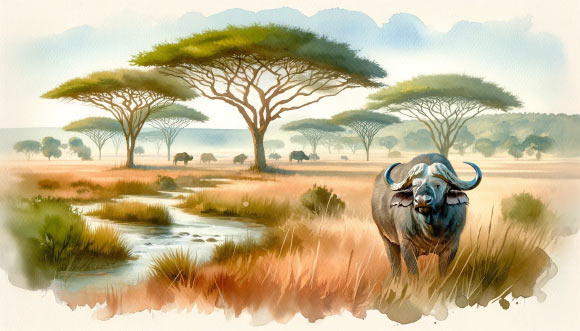Kromdraai is a Plio-Pleistocene site located in the Cradle of Humankind, South Africa. It has produced diverse and abundant faunal assemblages and key hominin specimens like Paranthropus robustus and early Homo. Paleontologists have now unearthed 2.9- to 1.8-million-year-old bovid fossils at Kromdraai, revealing the presence of previously unknown species that once roamed these ancient grasslands alongside our hominin ancestors.
Hanon et al. paint a vivid picture of a landscape dominated by expansive grasslands, hinting at the complex interplay of life that thrived in this region during the Plio-Pleistocene era. Image credit: Wits University.
“Paleontology often conjures images of dinosaurs, but studying modern animals like bovids is crucial too,” said Dr. Raphael Hanon, a researcher at the University of Witwatersrand.
“Bovids are diverse and successful in Africa, offering insights into both ancient and modern ecosystems.”
“Their evolutionary history is intertwined with ours, as they have been a key part of the landscape and human societies since the Miocene, about 23 million years ago.”
Bovids are members of the family Bovidae, which includes modern-day buffalo, antelopes, and gazelles.
Their diversity and abundance at the Kromdraai site offer a glimpse into the diets and behaviors of both large carnivores and our ancient relatives.
As prey, these animals shaped the predatory patterns of the region’s megafauna and, by extension, influenced the survival strategies of hominins such as Paranthropus robustus and early Homo species.
The discovery of extinct species of gazelles such as Gazella gracilior and the presence of a yet-to-be-named buffalo closely related to Syncerus acoelotus indicate a grassland-dominated environment.
This finding is corroborated by comparisons with other Plio-Pleistocene sites across South Africa, which suggest that different hominin species were associated with varying habitats.
While Australopithecus appeared to favor woodland and closed-wet environments, early Homo species were found in areas adapted to open and dry conditions.
The diverse range of bovids associated with Paranthropus, however, suggests a broad environmental adaptability among these hominins.
“One of the biggest challenges was to reconstruct and describe the small buffalo skull (Syncerus sp.) to identify it,” Dr. Hanon said.
“The skull was discovered as dozens of small broken bone pieces and we spent hours on it to be able to refit most of the pieces together so we would be able to tell what kind of animal it was.”
“Even after refitting all the pieces, it was very fragile — therefore difficult to manipulate and identify.”
“The fossil record of the African buffalo is scarce, especially in South Africa, so it was not easy to find relevant information that could help us identify the skull.”
The significance of these findings extends beyond the mere identification of ancient animals.
The bovid assemblages of Kromdraai, with their mix of older Plio-Pleistocene and younger Pleistocene taxa, offer a window into the changing landscapes of ancient Africa.
These changes, recorded in the bones and teeth of the bovids, reflect the dynamic nature of our planet’s ecosystems and the adaptability of life in the face of shifting climates and habitats.
Moreover, the study of these fossils provides a chronological marker for the site, with the biochronology indicating that Kromdraai Unit P accumulated between 2.9 and 1.8 million years ago.
This range is crucial for understanding the timeline of human evolution in the region, offering potential insights into the appearance of Paranthropus robustus and other significant species in southern Africa.
“The Kromdraai site continues to be a testament to the richness of our planet’s past, inviting scientists and enthusiasts alike to ponder the intricate connections between the Earth’s history and our origins,” the authors said.
The research is described in a paper in the journal Quaternary Science Reviews.
_____
Raphaël Hanon et al. 2024. New fossil Bovidae (Mammalia: Artiodactyla) from Kromdraai Unit P, South Africa and their implication for biochronology and hominin palaeoecology. Quaternary Science Reviews 331: 108621; doi: 10.1016/j.quascirev.2024.108621
>>> Read full article>>>
Copyright for syndicated content belongs to the linked Source : Sci-News.com – https://www.sci.news/paleontology/kromdraai-bovids-12925.html
